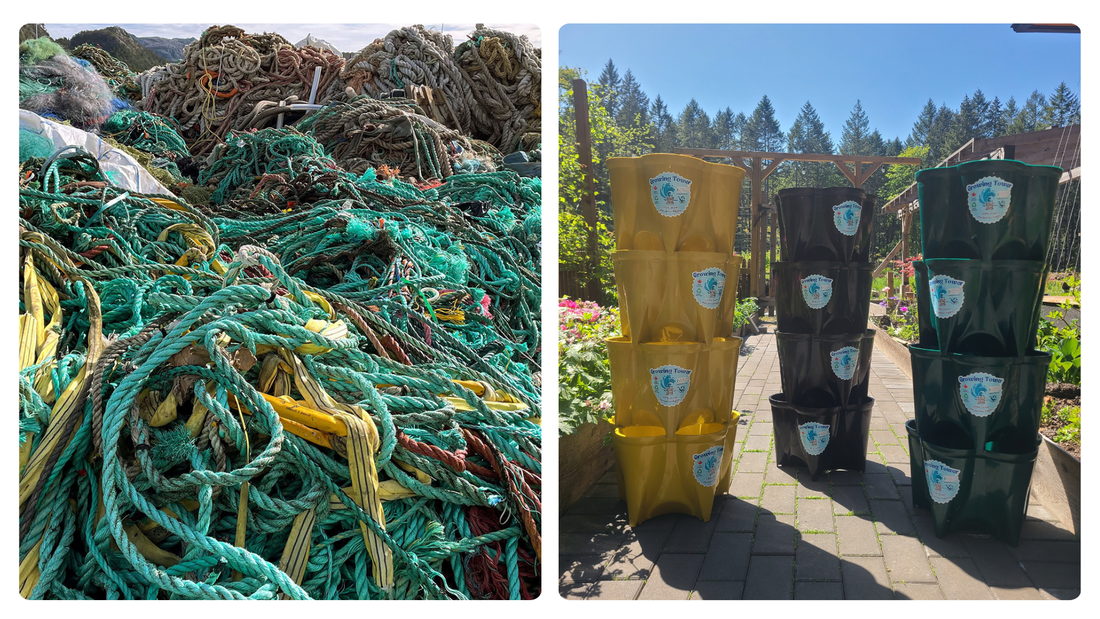
Cutting Carbon, Not Corners: How ReGarden Reduces Emissions by Recycling Plastic Locally
Share
Let’s talk about plastic and carbon.
Two environmental issues, one massive overlap. Plastics are usually seen as a pollution problem—but their carbon cost is just as serious. From oil extraction to overseas manufacturing, most plastic products leave a hefty trail of emissions behind.
That’s exactly what ReGarden, a Canadian-based recycling and manufacturing company, is out to change.
Instead of relying on global supply chains and virgin plastics, ReGarden keeps it local: collecting discarded marine ropes, processing them in British Columbia, and turning them into new, sustainable garden products. The result? A radically more responsible model that dramatically reduces carbon emissions.
ReGarden’s Plastic Story Starts in the Sea
A big chunk of ReGarden’s raw material isn’t easy to recycle — it’s retired fishing gear, especially polypropylene ropes used in aquatic fish farms off Vancouver’s coast.
Under B.C. law, these ropes must be replaced every seven years—even if they still look usable—because they begin to break down in seawater, shedding microplastics that can make their way into fish, and ultimately, people.
Rather than sending these materials to landfills or letting them drift as ghost gear, fish farms now collaborate with ReGarden to give them a second life.
“These ropes were never recycled before—not because they couldn’t be, but because it was hard, messy, and no one saw the value,” explains Ryan Anderson, ReGarden’s founder.
From Ropes to Results: The Emissions Equation
Why does this matter for carbon emissions?
Because plastic production is deeply tied to fossil fuels. Virgin plastic comes from oil. It’s extracted, refined, and then shipped—often globally—before ever reaching a factory. That whole chain produces an enormous amount of CO₂.
By replacing virgin plastic with locally recycled materials, ReGarden avoids that entire emissions-intensive supply chain.
Plus, they manufacture everything right here in Canada, which means:
● No long-haul international shipping
● No overseas factories
● No hidden carbon costs
That’s a big deal when you consider that freight is one of the dirtiest parts of the plastic industry. In fact, Ryan says it’s often the biggest cost—financially and environmentally—in their operation.
And of course, manufacturing products from virgin plastics contributes to 5% of the global carbon emissions.
There’s no reason to transport virgin plastic from locations such as Texas all the way to Canada, spending thousands of dollars to do so, when we have those resources here. That freight is a huge emitter of carbon emissions, and by recycling locally we can save money and cut down on emissions.
Cutting Transport, One Step at a Time
To take it even further, ReGarden is introducing on-site cleaning at fish farms. Why?
Because wet, dirty rope is heavier and bulkier to transport. That means more expensive, and more carbon intensive. By cleaning and stripping the materials before hauling, they’re cutting down on weight, reducing volume, and lowering the diesel fuel required to get it from point A to B.
For example, the freight for 12 tons of polypropylene rope from the northern tip of Vancouver Island costs over $13,000 to get it to Richmond, Vancouver. The rest of the process for recycling plastic is dwarfed by the freight costs. While it costs more than $1000 a ton to move the waste to the recycling plant, it costs only $600 to turn that ton of plastic waste into a finished product.
If we can clean, chip, and dry the plastic on site before shipping it, we will save thousands of dollars on freight, and also cut down on carbon emissions.
Producing the Growing Tower
Unlike larger operations that store plastic waste for weeks—or months—ReGarden moves fast.
Once the material arrives, it’s processed into plastic pellets within a week. We then produce products that can be taking back to market as fast as possible. The less plastic we’re warehousing, means the more products we can sell.
The more growing towers we can sell the more we can recycle.
Why Dirty Plastic Hasn’t Been Recycled Before
Let’s be real: recycling fish farm ropes isn’t easy. They’re often covered in seaweed, salt, and sand. For years, recyclers ignored them in favor of “cleaner” materials like post industrial waste that has a big volume and is clean.
But ReGarden leaned into the challenge. They built a viable market for a material that was once landfill-bound.
“It’s not about doing what’s easy,” Ryan says. “It’s about doing what’s needed—and proving that even hard-to-recycle waste has real value.”
The Power of Manufacturing Domestically
ReGarden’s commitment to local manufacturing is practical. By making all their products in Canada, they avoid the carbon emissions associated with:
● Container shipping
● Overseas warehousing
● Multiple cross-border supply chains
And because everything is made in small batches using verified recycled plastic, ReGarden maintains full control of quality, sustainability, and authenticity.
This is especially important in a marketplace crowded with greenwashed products—items that look sustainable but are often mass-produced abroad with vague or unverifiable eco claims.
ReGarden, by contrast, is working on a track-and-trace program to certify exactly where their plastic comes from, adding another layer of transparency for conscious consumers.
More Than Just Ropes: New Material Sources, Same Goals
While fishing ropes are the core feedstock, ReGarden is also exploring other sources of oceanbound plastic, including:
● Insulated fishing totes, which are recycled through a closed-loop program with a Canadian manufacturer.
● Oyster baskets, a common form of ghost gear (though they’re a less versatile material due to their coloring)
The team’s goal is to diversify the waste stream without compromising on emissions or product quality.
The Takeaway: Recycling Is Climate Action and saving money
ReGarden’s model shows that plastic recycling isn’t just about keeping waste out of the landfill —it's about reducing emissions and saving money.
Every rope they repurpose and every growing tower they build is proof that a circular, low-carbon future is possible — if we’re willing to rethink how we handle plastic from start to finish.
Instead of shipping it overseas, burning it, or burying it, they’re showing how we can keep materials in the loop right here at home, while building smarter products and lowering our footprint.
In a world full of noise, ReGarden is keeping it clear:
Use recycled plastic and reduce carbon emissions.
Interested in the full journey from ocean waste to finished product? Follow ReGarden on Instagram for behind-the-scenes updates, sustainability stories, and a growing line of low-impact gardening tools for better living.
